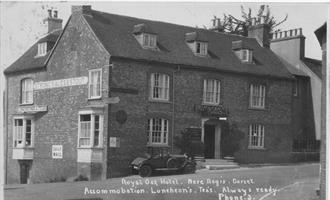The New Inn
In spite of its name this was one of the oldest of the village inns and contained 3 hearths in 1662.
It does not figure by name in the alehouse registers which give the names of the other inns after 1753, and is therefore more difficult to trace after about 1700 when the names of occupying tenants are not named in the rates.
Although it seems to have ceased to be an inn before 1753 the property was still called the New Inn for rating purposes until 1820 and was also so called on the 1844 tithe map, which shows it to have been situated on the north side of West Street, at the far west end on the site of the present no. 45 and extending somewhat beyond the end of the present terrace of cottages.
In 1777 the property was held by "S. Gould & Whennel," and in 1844 by Sarah Gould at which time it is described as "New Inn Garden Yards & Buildings."
It is not named as a public house in the trade directories which commence in 1830, but in 1842 Sansom Gould is described as a beer retailer, and Mrs. Sarah Gould occurs as a beer retailer in the directories for 1846, 1851 and 1853, as does also Mrs. Elizabeth Gould in 1859 and Thomas Gould in 1865. In the following list of innkeepers the later ones are conjectural:
1614-1631 William Penny occurs in the rates "for the new Inn." He died in May 1631.
1632-1657 William Wilcox occurs in the rates, and in the account for 1653 he received payments for the accommodation of travellers, but this could have been in his capacity of constable which post he then held.
1662-1664 Elizabeth Wilcox, presumably a widow, occurs in hearth tax returns. She could have been William Wilcox's widow, although a William Wilcox died in 1671,
1678-1690 Henry Trew occurs as ratepayer. A "Henery Trim" occurs as an innkeeper in the churchwardens account for 1687, and could be the same name.
In 17 century writing there are many variations of spelling, when i's and e's were often transposed and m's and w's looked very much alike.
1691-1703 Elizabeth Trew, widow occurs in the rates, but from 1704 onwards, in common with the other inns, the rates are paid by persons other than the licensees.
1717-1723 Thomas Fry appears in the alehouse registers and seems to be associated in the rates with George Chaldecott who was one of the ratepayers for the New Inn from 1735-1742.
1727-1728 Mary Brine, widow, occurs in the alehouse register in1727 and in the churchwardens accounts in 1728, and could possibly have been licensee of this inn.
1732 William Galton occurs in the alehouse register and could possibly have been licensee.
1733- 1736 John Whinnel occurs in the alehouse registers and could possibly have been licensee of this inn, particularly as a Whennel is named as one of the tenants in 1777.
The lack of further licensees in the alehouse registers suggest that the property ceased to be a licensed inn as such from this date, and to have become premises for retail trade only.



